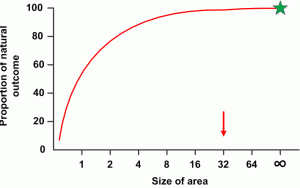A new important paper raises red flags about our preoccupation with tipping points, alternative stable states and regime shifts (I’ll call them collectively sharp transitions) in ecosystems (Capon et al. 2015). I do not usually call attention to papers but this paper and a previous review (Mac Nally et al. 2014) seem to me to be critical for how we think about ecosystem changes in both aquatic and terrestrial ecosystems.
Consider an oversimplified example of how a sharp transition might work. Suppose we dumped fertilizer into a temperate clear-water lake. The clear water soon turns into pea soup with a new batch of algal species, a clear shift in the ecosystem, and this change is not good for many of the invertebrates or fish that were living there. Now suppose we stop dumping fertilizer into the lake. In time, and this could be a few years, the lake can either go back to its original state of clear water or it could remain as a pea soup lake for a very long time even though the pressure of added fertilizer was stopped. This second outcome would be a sharp transition, “you cannot go back from here” and the question for ecologists is how often does this happen? Clearly the answer is of great interest to natural resource managers and restoration ecologists.
The history of this idea for me was from the 1970s at UBC when Buzz Holling and Carl Walters were modelling the spruce budworm outbreak problem in eastern Canadian coniferous forests. They produced a model with a manifold surface that tipped the budworm from a regime of high abundance to one of low abundance (Holling 1973). We were all suitably amazed and began to wonder if this kind of thinking might be helpful in understanding snowshoe hare population cycles and lemming cycles. The evidence was very thin for the spruce budworm, but the model was fascinating. Then by the 1980s the bandwagon started to roll, and alternative stable states and regime change seemed to be everywhere. Many ideas about ecosystem change got entangled with sharp transition, and the following two reviews help to unravel them.
Of the 135 papers reviewed by Capon et al. (2015) very few showed good evidence of alternative stable states in freshwater ecosystems. They highlighted the use and potential misuse of ecological theory in trying to predict future ecosystem trajectories by managers, and emphasized the need of a detailed analysis of the mechanisms causing ecosystem change. In a similar paper for estuaries and near inshore marine ecosystems, Mac Nally et al. (2014) showed that of 376 papers that suggested sharp transitions, only 8 seemed to have sufficient data to satisfy the criteria needed to conclude that a transition had occurred and was linkable to an identifiable pressure. Most of the changes described in these studies are examples of gradual ecosystem changes rather than a dramatic shift; indeed, the timescale against which changes are assessed is critical. As always the devil is in the details.
All of this is to recognize that strong ecosystem changes do occur in response to human actions but they are not often sharp transitions that are closely linked to human actions, as far as we can tell now. And the general message is clearly to increase rigor in our ecological publications, and to carry out the long-term studies that provide a background of natural variation in ecosystems so that we have a ruler to measure human induced changes. Reviews such as these two papers go a long way to helping ecologists lift our game.
Perhaps it is best to end with part of the abstract in Capon et al. (2015):
“We found limited understanding of the subtleties of the relevant theoretical concepts and encountered few mechanistic studies that investigated or identified cause-and-effect relationships between ecological responses and nominal pressures. Our results mirror those of reviews for estuarine, nearshore and marine aquatic ecosystems, demonstrating that although the concepts of regime shifts and alternative stable states have become prominent in the scientific and management literature, their empirical underpinning is weak outside of a specific environmental setting. The application of these concepts in future research and management applications should include evidence on the mechanistic links between pressures and consequent ecological change. Explicit consideration should also be given to whether observed temporal dynamics represent variation along a continuum rather than categorically different states.”
Capon, S.J., Lynch, A.J.J., Bond, N., Chessman, B.C., Davis, J., Davidson, N., Finlayson, M., Gell, P.A., Hohnberg, D., Humphrey, C., Kingsford, R.T., Nielsen, D., Thomson, J.R., Ward, K., and Mac Nally, R. 2015. Regime shifts, thresholds and multiple stable states in freshwater ecosystems; a critical appraisal of the evidence. Science of The Total Environment 517(0): in press. doi:10.1016/j.scitotenv.2015.02.045.
Holling, C.S. 1973. Resilience and stability of ecological systems. Annual Review of Ecology and Systematics 4: 1-23. doi:10.1146/annurev.es.04.110173.000245.
Mac Nally, R., Albano, C., and Fleishman, E. 2014. A scrutiny of the evidence for pressure-induced state shifts in estuarine and nearshore ecosystems. Austral Ecology 39: 898-906. doi:10.1111/aec.12162.
